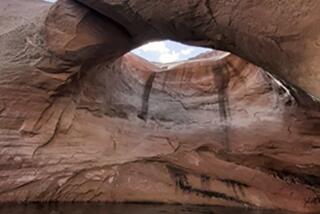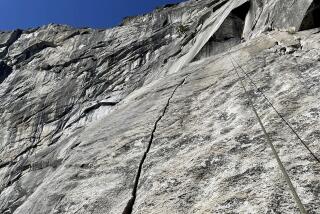Great Sphinx Loses Chunk of Limestone
- Share via
GIZA PLATEAU, Egypt — A chunk of limestone has fallen off the 4,600-year-old Great Sphinx, and authorities said Thursday that if the cracking monument is left untreated, its entire right shoulder will collapse.
The first significant break on the statue since 1981 occurred Sunday, six days after a sandstorm battered the Great Sphinx and the famed Giza Pyramids nearby.
Culture Minister Farouk Hosni surveyed the damage Thursday and said the monument must be studied to decide what restoration efforts should be taken.
“Any pain to any ancient monument has to reach all over the world, because it is an extremely important object of value,” he said. “In this case, the Sphinx is not only one of the most important monuments in Egypt but in the world,” he said.
Egyptologist Zahi Hawass, director general of Giza Plateau, cautioned that “if nothing is done, the shoulder will fall.”
A guard for the Egyptian Antiquities Organization told officials that he heard a crash early Sunday, and when he investigated, he found two pieces of stone, each about 16 inches wide by 28 inches long, and smaller chunks. Experts said the pieces came from one boulder that broke loose about halfway up the shoulder.
Hawass said he believes the rock came loose because salt inside the Great Sphinx’s body eroded away the stone. The wind then broke it away.
Despite the danger of a major collapse, Hawass said he doesn’t think large-scale restoration work is called for.
“We need to make chemical injections into the shoulder, like injections to the shoulder and chest that were given 10 years ago,” he said.
The limestone statue is the oldest and largest of its kind, standing 66 feet high and extending 240 feet long. It has the body of a crouching lion and the face of a pharaoh thought to be Chephren, builder of the second Giza Pyramid. Chephren’s father was Cheops, who built the Great Pyramids.
Over the ages, the Great Sphinx has suffered many perils. Much of the structure has been buried periodically by shifting sands, and as late as the mid-19th Century, it was buried to its neck.
About 3,500 years ago, the Great Sphinx acquired a beard. It fell during antiquity, but the pieces are in the Egyptian Museum in Cairo except for a fragment in the British Museum.
More to Read
Sign up for Essential California
The most important California stories and recommendations in your inbox every morning.
You may occasionally receive promotional content from the Los Angeles Times.









